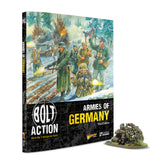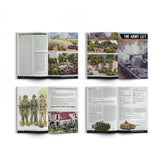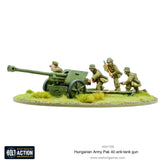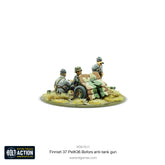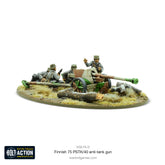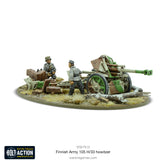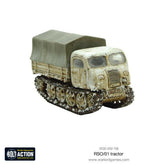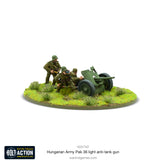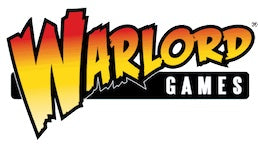Additional Axis Armies
Filter by Axis Army : Finland; Romania; Bulgaria; Hungary;
The Axis powers, also known as "Rome–Berlin–Tokyo Axis", grew from a series of treaties through the 1930s. Initially between Germany and Italy. A declaration by Benito Mussolini late in 1936 stated that all other European countries would from then on rotate on the Rome–Berlin axis, thus creating the term "Axis".
Japan joined the pact with the signing of an anti-communist treaty and by 1939 the "Rome–Berlin Axis" had become a military alliance. During World War II, the Axis presided over territories that occupied large parts of Europe, North Africa, and East Asia.
Finland ▼
Finland’s role during World War II was both unique and remarkable. The Finns achieved spectacular military successes against the Soviet Union despite being heavily outnumbered and lacking much in the way of modern equipment including tanks and anti-tank weapons.
Finland’s war against the Soviets was in many respects a separate affair, and the Finns themselves certainly tend to consider it as such. Once the Soviets joined the Allied camp following Hitler’s invasion of Russia, Finland had no option left but to seek aid from Germany, so although never officially part of the tripartite pact of Germany, Italy and Japan, Finland was regarded as an Axis power during the post-war settlement.
Romania ▼
The Romanian oilfields were of great importance to Nazi Germany, and critical to the operation of the Axis war machine. Preserving access to this resource was of prime importance. In June of 1940, the Soviet Union issued an ultimatum to the Romanian government that was to result in Romania surrendering the territories of Bessarabia, Northern Bukovina, and Hertza to the Soviets. This Soviet threat to the oil fields convinced Hitler that, one way or the other, Romania must be secured.
When Hitler finally decided to go to war with Russia, Romania was key to his plans. A large number of Romanian troops were involved in Operation Barbarossa and the Romanian Army loyally supported the Axis cause as they pushed through the Crimea as far as Stalingrad. Stalingrad was a major defeat for the Romanians, and a general retreat followed through the Caucasus.
Bulgaria ▼
Bulgaria intended to maintain its neutrality at the start of hostilities. In 1941, German troops moved through Bulgaria to reinforce the Italians fighting in Greece, and Bulgaria found itself drawn into the conflict. Bulgaria joined the Tripartite Pact and became one of the Axis powers, but played little part in the wider war.
Bulgarian troops did take part in the fighting in Greece, where the country’s leaders took the opportunity to expand its borders to the south and west. These territorial ambitions were local affairs, a matter of dispute since World War I, and Bulgaria’s chief war aims were to annexe what it saw as natural Bulgarian territory within its neighbour’s borders.
Hungary ▼
The Hungarian forces were put under the overall command of the German Wehrmacht and used in Operation Barbarossa, pushing as far as Stalingrad. The Hungarian army swelled from a peacetime strength of 80,000 to over 200,000. The force’s effectiveness was dampened by ineffective equipment and limited training as well as by the harsh weather.
The well-supplied but quickly trained Hungarian Second Army accompanied the German Second Army Group South in the invasion of southern Russia, finally arriving at the battle of Stalingrad. The Hungarians were dealt a huge defeat in the face of a Russian pincer attack near Svoboda on the Don River. This effectively destroyed the Hungarian Second Army as a fighting force.
After the battle of Stalingrad and the crushing defeat of the Second Hungarian Army, most Hungarian forces were switched to defence as anti-Axis sentiment grew at home. The prime minister saw the writing on the wall and started secret negotiations with the Allies. Though the Allies kept negotiations secret from the Soviets, the Germans discovered them, resulting in a German invasion of Hungary in the spring of 1944.
- 10
- 15
- 20
- 25
- 30
- 50
- Featured
- Best selling
- Alphabetically, A-Z
- Alphabetically, Z-A
- Price, low to high
- Price, high to low
- Date, old to new
- Date, new to old
Sort by:
- Featured
- Best selling
- Alphabetically, A-Z
- Alphabetically, Z-A
- Price, low to high
- Price, high to low
- Date, old to new
- Date, new to old
-
Hungarian Army HQSince 1872, the Ludovica Military Academy had been turning out competent and efficient officers and graduated the majority of officers for the Hungarian Army. A core of competent and educated officers struggled to handle the large expansion of the Hungarian Army to meet the...
- £7.65
£9.00- £7.65
- Unit price
- / per
-
Hungarian Army Pak 40 anti-tank gunWebstore Exclusive! This artillery piece is supplied with a laser-cut oval MDF base (120mm x 92mm) - only available through this webstore. You can now base your complete gun and crew together, making attractive mini-dioramas! The 7.5 cm PaK 40 (7.5 cm Panzerabwehrkanone 40)...
- £20.40
£24.00- £20.40
- Unit price
- / per
-
Finnish 20 ITK/38 anti-aircraft gunContains 1 metal anti-aircraft gun and 3 crew. Note: Models supplied unassembled and unpainted.
- £16.15
£19.00- £16.15
- Unit price
- / per
-
Finnish 37 PstK/36 Bofors anti-tank gunFaced with the vast forces of the Soviets, the courageous and resourceful Finnish soldiers, masters of fieldcraft, sniping, and small unit tactics, slowed and then began to roll back the massive Soviet assaults. Pack contains 1 metal gun and 3 metal foot figures. Note:...
- £16.15
£19.00- £16.15
- Unit price
- / per
-
Finnish 75 PSTK/40 anti-tank gunWebstore Exclusive! This artillery piece is supplied with a laser-cut oval MDF base (120mm x 92mm) - only available through this webstore. You can now base your complete gun and crew together, making attractive mini-dioramas! Contains 1 metal gun and 4 crew. Note: Models...
- £20.40
£24.00- £20.40
- Unit price
- / per
-
Finnish Army 105 H/33 howitzerWebstore Exclusive! This artillery piece is supplied with a laser-cut oval MDF base (120mm x 92mm) - only available through this webstore. You can now base your complete gun and crew together, making attractive mini-dioramas! Faced with the vast forces of the Soviets, the...
- £22.53
£26.50- £22.53
- Unit price
- / per
-
RSO/01 tractorContains one Resin and Metal vehicle Models supplied unassembled and unpainted
- £20.83
£24.50- £20.83
- Unit price
- / per
-
Hungarian Army Pak 36 light anti-tank gunSupplied by the Germans, the Hungarians utilised the 37mm PaK 36 as a light anti-tank gun. A version of the PaK 36 was produced to use the 40mm calibre ammunition of the Hungarian made Skoda A17 anti-tank gun. The Pak 36 knocked out thousands...
- £16.15
£19.00- £16.15
- Unit price
- / per
-
Hungarian Army 44M 'mace thrower' rocket launcherRoughly translated as the ‘mace-thrower’, the 44M Buzogányvető was a prototype rocket weapon designed towards the end of the war. The dual unguided rockets were mounted on either captured and converted Soviet Maxim MG wheeled carriages, or a custom tripod. Of the 600–700 rocket...
- £16.15
£19.00- £16.15
- Unit price
- / per
-
Hungarian 37M medium artilleryWebstore Exclusive! This artillery piece is supplied with a laser-cut oval MDF base (100mm x 80mm) - only available through this webstore. You can now base your complete gun and crew together, making attractive mini-dioramas! Designed and built by Skoda, this howitzer was first...
- £22.53
£26.50- £22.53
- Unit price
- / per






